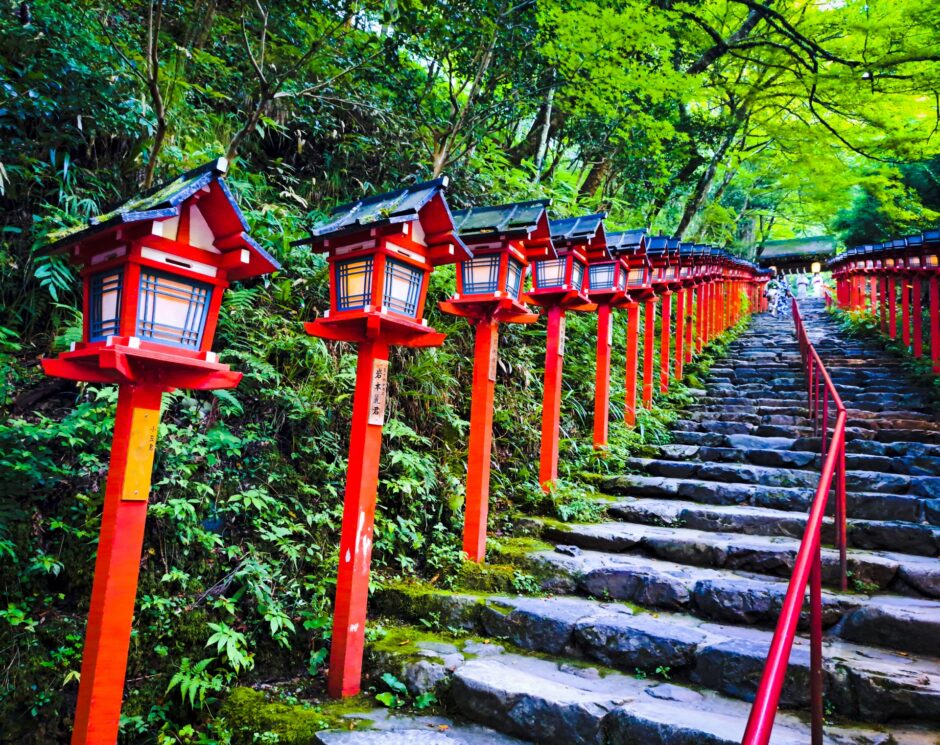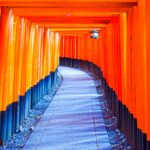【Kifune Shrine summary】
Kifune Shrine is the head shrine of the Water Gods. The shrine is located in the mountains from the center of Kyoto. According to legend, the shrine was founded about 1,600 years ago by Princess Tamayoribime, the mother of the first Emperor Jinmu, who took a boat from present-day Osaka Bay to pray for rain.
The deity is Takanakami-no-kami, the god of water goddesses and the son of Izanagino-no-mikoto. According to the Kojiki and Nihonshoki, Takakanokami was the god of water, born from the blood dripping from the tip of the sword when Izanagi no Mikoto killed Kagutsuchi, the fire god who had caused the death of Izanami no Mikoto, with the Ametokutsuka no Tsurugi (Sword of Heaven). At this time, the three noble deities such as Amaterasu had not yet been born. From this point of view, Kibune Shrine is an ancient shrine.
【Kifune Shrine scenery】
![Kifune Shrine [Kyoto] DSC 0698 1024x652 - Kifune Shrine [Kyoto]](https://japan-shrine.info/wp-content/uploads/DSC_0698-1024x652.jpg)
The mountain path leading to the shrine with a view of the inn on the riverbed is very relaxing and picturesque. The shrine is beautiful in every season, so you can enjoy the scenery no matter what season you visit. During the season of autumn leaves, the shrine is open at night.
![Kifune Shrine [Kyoto] DSC 0701 1024x710 - Kifune Shrine [Kyoto]](https://japan-shrine.info/wp-content/uploads/DSC_0701-1024x710.jpg)
The shrine is built in a narrow space between a forest and a river, and the harmony of greenery and water creates a very pleasant atmosphere, where you can feel your heart calm down.
【Kifune Shrine premises】
![Kifune Shrine [Kyoto] DSC 0704 1024x644 - Kifune Shrine [Kyoto]](https://japan-shrine.info/wp-content/uploads/DSC_0704-1024x644.jpg)
Kibune Shrine is also famous as the birthplace of the ema (votive picture horse). Since ancient times, the shrine has been worshipped as a god of praying for rain, and successive emperors used to dedicate a black horse in times of drought and a white horse in times of long rains to pray. The shrine was originally dedicated to a real horse as a token of thanks for their prayers and requests, but the shrine became troubled and wrote their wishes on a wooden board.
![Kifune Shrine [Kyoto] DSC 0705 1024x768 - Kifune Shrine [Kyoto]](https://japan-shrine.info/wp-content/uploads/DSC_0705-1024x768.jpg)
【Kifune Shrine Okumiya】
The Okumiya Shrine of Kibune Shrine is located about 500 meters (about 15 minutes’ walk) up the mountain from Kibune Shrine. There are not many visitors to the shrine, either because they do not know about the Okumiya Shrine or because the tour participants do not go to the Okumiya Shrine due to time constraints.
![Kifune Shrine [Kyoto] DSC 0708 1024x768 - Kifune Shrine [Kyoto]](https://japan-shrine.info/wp-content/uploads/DSC_0708-1024x768.jpg)
The present Okumiya Shrine is located where the main shrine of Kibune Shrine used to be. The main shrine was swept away and relocated to the current location, and beneath the main hall of the Okumiya shrine is one of the three largest dragon holes in Japan, Kibune’s Dragon Hole. The Kibune Ryu-ana is one of the three great dragon holes in Japan, along with the Muro Ryu-ana in Yamato (Nara Prefecture) and the Bizen Ryu-ana in Okayama (Okayama Prefecture).
![Kifune Shrine [Kyoto] DSC 0710 1024x739 - Kifune Shrine [Kyoto]](https://japan-shrine.info/wp-content/uploads/DSC_0710-1024x739.jpg)
It is said that there is a dragon hole under this main shrine, and there is a gonchi next to it. It is said that the main shrine was built and moved to this gonchi because it is forbidden to stand on top of the dragon pit, let alone look into it. It has a different solemnity from the main shrine.
![Kifune Shrine [Kyoto] DSC 0711 1024x768 - Kifune Shrine [Kyoto]](https://japan-shrine.info/wp-content/uploads/DSC_0711-1024x768.jpg)
【Kifune Shrine Yuino】
The path from the main shrine to the inner shrine is pleasant with the murmuring of the river. The Yui no Yashira shrine is located between the main shrine and the inner shrine of Kibune Shrine, connecting the two shrines.
![Kifune Shrine [Kyoto] DSC 0712 1024x768 - Kifune Shrine [Kyoto]](https://japan-shrine.info/wp-content/uploads/DSC_0712-1024x768.jpg)
Kibune Shrine is famous for marriage, and its deity, Iwanagahime no Mikoto, is enshrined in this nakamiya (shrine). We stopped at the Nakamiya Shrine, where the main deity is enshrined, for the last time.
【Kifune Shrine GOSHUIN】
![Kifune Shrine [Kyoto] kifunejinja 706x1024 - Kifune Shrine [Kyoto]](https://japan-shrine.info/wp-content/uploads/kifunejinja-706x1024.jpg)
【Kifune Shrine Access】
It is about 2 km away from Kibunaguchi station, so do not walk there, but there is a bus from the station to near the shrine. The road is very narrow, only 1.5 lanes wide, so it is not recommended to drive there. There are no sidewalks, but there are many pedestrians, and it is very difficult to pass each other because of the frequent buses and store shuttles.
Manager’s Comments
There are many kawadoko restaurants along the road, a Kyoto tradition, where you can dine and rest near the river, and it is a great way to experience the land from which the Kibune Shrine originates. However, access is not easy and it is also crowded for that reason, so I would recommend early morning with advance planning.
180 Kurama Kibune-cho, Sakyo-ku, Kyoto-shi, Kyoto 601-1112
※There is a paid parking lot nearby, but the further you go, the narrower it gets, so it is recommended that you do not go too far ahead and walk.
 Tour of Japanese shrines and temples
Tour of Japanese shrines and temples 

![Kifune Shrine [Kyoto] 77418ee73675e3a27e351cbcaf759ac4 - Kifune Shrine [Kyoto]](https://japan-shrine.info/wp-content/uploads/sng/77418ee73675e3a27e351cbcaf759ac4.png)
![Kifune Shrine [Kyoto] DSC 0684 150x150 - Kifune Shrine [Kyoto]](https://japan-shrine.info/wp-content/uploads/DSC_0684-150x150.jpg)
![Kifune Shrine [Kyoto] shimogamo shrine kyoto jp1 150x150 - Kifune Shrine [Kyoto]](https://japan-shrine.info/wp-content/uploads/shimogamo-shrine-kyoto-jp1-150x150.jpg)
![Kifune Shrine [Kyoto] Gen Ise nekomiya Imperial Grand Shrine【Kyoto】3 150x150 - Kifune Shrine [Kyoto]](https://japan-shrine.info/wp-content/uploads/Gen Ise-nekomiya Imperial Grand Shrine【Kyoto】3-150x150.jpg)


